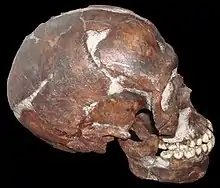Qafzeh cave
Qafzeh cave (Hebrew: מערת קפזה, romanized: Me'arat Qafzeh) means “precipice”, also known as Kedumim cave (Hebrew: מערת קדומים, romanized: Me'arat Kedumim) or Ha'kfitza cave (Hebrew: מערת הקפיצה, romanized: Me'arat Hakfitzah), is a prehistoric archaeological site located at the bottom of Mount Precipice (Hebrew: הר קדומים, "Har Kedumim"), in the Jezreel Valley of the Lower Galilee, south of Nazareth.[1][2] Important remains of prehistoric people were discovered on the site - some of the oldest examples in the world, outside of Africa, of virtually anatomically modern human beings.[3][4] These were discovered on the ledge just outside the cave, where 18 layers from the Middle Paleolithic era were identified. The interior of the cave contains layers ranging from the Neolithic era to the Bronze age.[5]
Excavations
Excavations of the site began in 1932, by Moshe Stekelis and René Victor Neuville, but were interrupted due to a collapse.[5] In 1936, during the Arab rebellion in Palestine, the British blew up the cave because it was being used as a hideout by gangs associated with the rebels.[5] Excavations were renewed in 1965,[4][5] by Bernard Vandermeersch, Ofer Bar-Yosef, then continued, intermittently, until 1979.[1]
Findings

Among the finds on the site are stoves, stone tools belonging to the Mousterian culture, and also human and animal bones, which attest to the fact that the cave had been used both for residence and as a burial site. The remains of 15 human skeletons were discovered on site, in a Mousterian archaeological context. Seven of them are skeletons of adults and the rest - of children. The high proportion of children skeletons is unique among Middle Palaeolithic sites, and it led researchers to look for signs of trauma or disease that might have led to their premature deaths. One child, Qafzeh 12, of around 3 years of age, by modern reference standards, had abnormalities indicating hydrocephalus.[6] Five of these skeletons were found buried in an orderly fashion in the cave's floor, of which 2 were found with deer horns lying in their hands. The site was dated to circa 92,000 BP, using Thermoluminescence.[2]
Human remains founded in the cave were preserved at the Institut de paléontologie humaine (IPH) de Paris and the largest part of Neville’s lithic series was preserved at the Rockefeller Museum in Jerusalem.[2][7]
One such burial is of a 10 year old boy from the earliest of the Middle Paleolithic layers, who was buried in a rectangular grave carved out of the bedrock, with his arms folded alongside his body and his hands placed on either side of his neck. Deer horns were laid on his hands, probably constituting one of the offerings put in the grave. The boy's skull bears signs of a head trauma that had probably been the cause of death.[4][8]
Skeletons, isolated bones and teeth found in the cave belong to at least 28 people.[9][10] Remains of Qafzeh 9 and 10 are nearly complete.[11]
An additional important find was the remains of ochre that were found on human bones, and, also, 71 pieces of ochre that were associated with burial practices, which indicates that ceremonial funerary rites that included symbolic acts which held special meaning had already been common around 100,000 years ago.[12] Ochre was used for body dyeing and ornamentation. It was also used during the burial of a brain damaged child that was found in the cave. Red, black and yellow ochre-painted seashells were found around the cave.[1][13]
Stone tools
The stone tools discovered at the site - side scrapers, disc cores and points - were of the Levallois-Mousterian type. These tools are often associated with Neanderthal settlements. Animal remains of horse, woodland-adapted red deer, rhinoceros, fallow deer, wild ox and gazelle, land snails were also found at the site stand for Mousterian and Upper Paleolithic period.[3][1]
See also
References
- Quotations, K. Kris Hirst K. Kris Hirst is an archaeologist with 30 years of field experience She is the author of The Archaeologist's Book of; Science, her work has appeared in; Archaeology. "Evidence for 90,000 Year Old Human Burials at Qafzeh Cave, Israel". ThoughtCo. Retrieved 10 April 2019.
- Vandermeersch, Bernard (30 March 2002). "The excavation of Qafzeh". Bulletin du Centre de Recherche Français à Jérusalem (10): 65–70. ISSN 2075-5287.
- "The Palaeolithic Jebel Qafzeh Cave in Palestine". ancientneareast.tripod.com. Retrieved 25 November 2017.
- "מערת קדומים (קפצה)1969". Hadashot Arkheologiyot / חדשות ארכיאולוגיות. לא/לב: 7. 1969. JSTOR 23476384.
- מערת קדומים \ קפזה\ קפצה - עמוד ענן. amudanan.co.il (in Hebrew). Retrieved 25 November 2017.
- Tillier, Anne-Marie; Arensburg, Baruch; Duday, Henri; Vandermeersch, Bernard (1 February 2001). "Brief communication: An early case of hydrocephalus: The Middle Paleolithic Qafzeh 12 child (Israel)". American Journal of Physical Anthropology. 114 (2): 166–170. doi:10.1002/1096-8644(200102)114:2<166::aid-ajpa1017>3.0.co;2-3. ISSN 1096-8644. PMID 11169907.
- "Qafzeh | anthropological and archaeological site, Israel". Encyclopedia Britannica. Retrieved 10 April 2019.
- Tillier, Anne-marie; Vandermeersch, Bernard; Duday, Henri; Arensburg, Baruch; Dutour, Olivier; Coqueugniot, Hélène (23 July 2014). "Earliest Cranio-Encephalic Trauma from the Levantine Middle Palaeolithic: 3D Reappraisal of the Qafzeh 11 Skull, Consequences of Pediatric Brain Damage on Individual Life Condition and Social Care". PLOS One. 9 (7): e102822. Bibcode:2014PLoSO...9j2822C. doi:10.1371/journal.pone.0102822. ISSN 1932-6203. PMC 4108366. PMID 25054798.
- Tillier, Anne-Marie (2014). "New Middle Palaeolithic Hominin Dental Remains from Qafzeh, Israel". Paléorient. 40 (1): 13–24. doi:10.3406/paleo.2014.5614.
- Coutinho Nogueira, Dany (2019). Paléoimagerie appliquée aux Homo sapiens de Qafzeh (Paléolithique moyen, Levant sud). Variabilité normale et pathologique (in French). Université Paris sciences et lettres. p. 211.
- Vandermeersch, Bernard (30 March 2002). "La fouille de Qafzeh. Son apport à la connaissance du Moustérien de Levant". Bulletin du Centre de recherche français à Jérusalem (in French) (10): 11–16. ISSN 2075-5287.
- "Cave colours reveal mental leap". 11 December 2003. Retrieved 25 November 2017.
- Hovers, Erella; Ilani, Shimon; Bar Yosef, Ofer; Vandermeersch, Bernard (2003). "An Early Case of Color Symbolism: Ochre Use by Modern Humans in Qafzeh Cave". Current Anthropology. 44 (4): 491. doi:10.1086/375869. JSTOR 10.1086/375869.
Further reading
- Yehuda Rut, The Forgotten Cave, in Al Hamishmar, 1959.
- Qafzeh, History of Discoveries, by Bernard Vandermeersch.